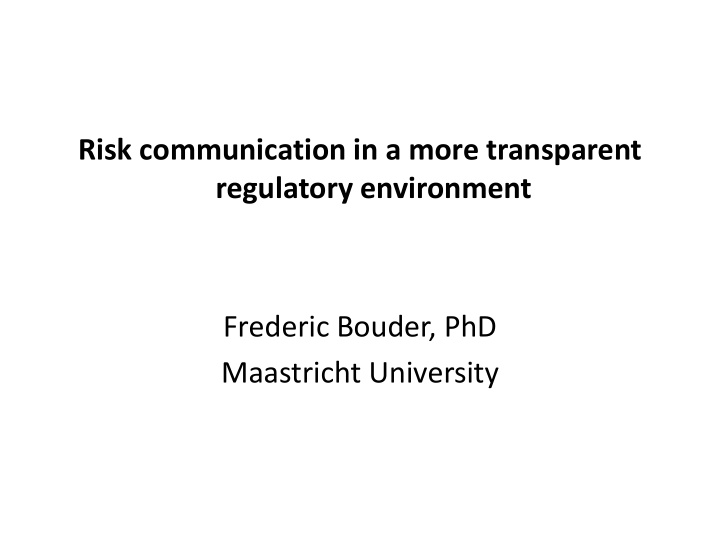



Risk communication in a more transparent regulatory environment Frederic Bouder, PhD Maastricht University
This talk 1- Convey science- based “view point” from Ragnar Lofstedt and myself on the crucial question of communicating risk in a more transparent environment 2- In particular the need to think more strategically about the impact of the new transparency policy 3- Recommendations to move forward and build trust
Pharmaceutical sector on trial • Vioxx Cox2 • Avandia • Mediator “Accused”: Industry and increasingly regulatory Agencies “Accusers”: Politicians (e.g. Senator Grassley), critical stakeholder (e.g. Public Citizen), medical journal (BMJ, JAMA, NEJM) , certain academics
Charges Industry covering up negative results (IOM 2009) Authors not properly disclosing company payments (Chimonas et al. 2011) Academics, patient groups and charities funded by industry, while serving on advisory boards (Krumholz et al. 2007) Articles ghost written in medical journals (Flanagin et al. 1998) Regulators too close to industry (Grassley 2004&2007; Hampton 2011) Institutional bias (Abraham&Lewis 2002) – e.g. ICH (Abraham and Reed 2002)
Remedies - 1 Independent data and safety monitoring boards whose governance should not be pharma industry controlled (Krumolz et al. 2007) Editorials by respected academics with no conflict of interest to contextualise clinical trial findings (Ibid.) Industry should release as much information as possible and allow independent scrutiny : concerns for intellectual property are misplaced (Godlee and Clarke 2009) Prohibit free bees (Brennan et al. 2006)
Remedies - 2 Internet sites with information on consulting agreements and unconditional grants (Mitchell 2009) Uniform format for disclosure of competing interests in all medical journals (IOM 2009; Drazen et al. 2010) Medical experts advising international bodies (e.g. WHO) should declare possible conflicts of interest before advising (Godlee 2010) Full public access to all trial protocols and results (Chan 2008; Doshi et al. 2011)
Our crucial point Although we do not contest most of the premise from where these critics are coming we beg to ask: 1- Have the recommendations been properly tested? 2- Science or “pseudo science”? 3- What about evidence-based communication (Fischhoff et al. 2011)?
The “accused” agrees with “accusers” that transparency is the solution to regain trust “Transparency is a potent element of a successful strategy to enhance the work of the FDA and its credibility with the public” (Hamburg and Sharfstein 2009) “Transparency is here to stay - everything else is just stone age” (Senior European pharma regulator 2009)
Transparency has + and - (Ditchley 1) Secrecy destroys trust while transparency builds it (Breakwell 2007; Löfstedt 2005) Being seen as open and honest (Matsumoto et al. 2005; Schutz and Wiedemann 2000) Muddling and bickering exposed (Lindbloom 1959; Stone 2001) Disenchantment (Bovens and Willie 2008; Grimmelikhuijsen 2010) Trustworthiness framed by pre-existing views (van de Walle 2004) More knowledge = more criticism (Mandak et al. 2009)
Teething problems of pharma transparency policy Do we communicate benefits and risks or do we draw attention to risks only? How can regulators share and align with each other before communicating externally? How do we keep information contextualised? Are institutional non-regulatory voices (sponsors, patient associations, medical associations etc) de facto marginalised?
Where are we now in Europe? http://www.adrreports.eu/
How will publics and patients deal with more technical information? They will be fine (Hamburg and Sharfstein 2009; Seligman and Osborne 2009) Yet ... People don’t admit that they are ignorant (Fischer 1993) Unclear whether publics are as sophisticated as regulators and pharma critics imply (Chakraborty and Löfstedt 2012) e.g. negative impact of negative AERs posting on compliance (Löfstedt et al. 2012)
Example: Periodic Safety Update reports (PSURs) Historically a confidential document between company and regulator 100s pages, legalistic and technical (medical) Who wants access? Mostly competitors to identify weaknesses Critics Cochrane reviewers types to conduct “meta analyses” Editors of medical journals Eichler et al. 2012
Yet... Lawyers may demand equal access to PSURs in other markets Companies may stop filing for fear of leaks May reduce number of clinical trials (Cahoy 2007) Industry and other body may create less information as seen in financial sector Need for “protected space” may be felt (Coglianese et al. 2009)
Most importantly Are patients really interested in raw data? “ I think a lot of us are advocating a lot of transparency, a lot of disclosure early in the process but saying that there needs to be public education. There needs to be a more developed context to accountability that so you don’t have the sort of whiplash panic and then overdose”. Ms Mayer, a breast cancer survivor, to the US FDA’s Risk Communication Advisory Committee Making patients involvement a routine on sensitive issues helps (EMA 2011)
Recommendations
1- Independent risk communication advisory boards 2- Strengthening the communication departments of pharmaceutical regulators 3- Pre- testing and evaluating one’s communication messages 4- Training regulatory officials in risk communication 5- Developing a guide/handbook on risk communication for pharma sector 6- Promote science-based pharmaceutical risk communication
Recommend
More recommend